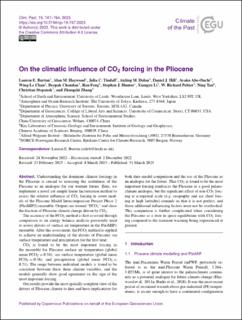| dc.contributor.author | Burton, Lauren E. | |
| dc.contributor.author | Haywood, Alan M. | |
| dc.contributor.author | Tindall, Julia C. | |
| dc.contributor.author | Dolan, Aisling M. | |
| dc.contributor.author | Hill, Daniel J. | |
| dc.contributor.author | Abe-Ouchi, Ayako | |
| dc.contributor.author | Chan, Wing-Le | |
| dc.contributor.author | Chandan, Deepak | |
| dc.contributor.author | Feng, Ran | |
| dc.contributor.author | Hunter, Stephen J. | |
| dc.contributor.author | Li, Xiangyu | |
| dc.contributor.author | Peltier, W. Richard | |
| dc.contributor.author | Tan, Ning | |
| dc.contributor.author | Stepanek, Christian | |
| dc.contributor.author | Zhang, Zhongshi | |
| dc.date.accessioned | 2023-09-01T12:56:49Z | |
| dc.date.available | 2023-09-01T12:56:49Z | |
| dc.date.created | 2023-06-16T14:57:44Z | |
| dc.date.issued | 2023 | |
| dc.identifier.citation | Climate of the Past. 2023, 19 (3), 747-764. | en_US |
| dc.identifier.issn | 1814-9324 | |
| dc.identifier.uri | https://hdl.handle.net/11250/3087056 | |
| dc.description.abstract | Understanding the dominant climate forcings in the Pliocene is crucial to assessing the usefulness of the Pliocene as an analogue for our warmer future. Here, we implement a novel yet simple linear factorisation method to assess the relative influence of CO2 forcing in seven models of the Pliocene Model Intercomparison Project Phase 2 (PlioMIP2) ensemble. Outputs are termed “FCO2” and show the fraction of Pliocene climate change driven by CO2. The accuracy of the FCO2 method is first assessed through comparison to an energy balance analysis previously used to assess drivers of surface air temperature in the PlioMIP1 ensemble. After this assessment, the FCO2 method is applied to achieve an understanding of the drivers of Pliocene sea surface temperature and precipitation for the first time. CO2 is found to be the most important forcing in the ensemble for Pliocene surface air temperature (global mean FCO2=0.56), sea surface temperature (global mean FCO2=0.56), and precipitation (global mean FCO2=0.51). The range between individual models is found to be consistent between these three climate variables, and the models generally show good agreement on the sign of the most important forcing. Our results provide the most spatially complete view of the drivers of Pliocene climate to date and have implications for both data–model comparison and the use of the Pliocene as an analogue for the future. That CO2 is found to be the most important forcing reinforces the Pliocene as a good palaeoclimate analogue, but the significant effect of non-CO2 forcing at a regional scale (e.g. orography and ice sheet forcing at high latitudes) reminds us that it is not perfect, and these additional influencing factors must not be overlooked. This comparison is further complicated when considering the Pliocene as a state in quasi-equilibrium with CO2 forcing compared to the transient warming being experienced at present. | en_US |
| dc.language.iso | eng | en_US |
| dc.rights | Navngivelse 4.0 Internasjonal | * |
| dc.rights.uri | http://creativecommons.org/licenses/by/4.0/deed.no | * |
| dc.title | On the climatic influence of CO2 forcing in the Pliocene | en_US |
| dc.title.alternative | On the climatic influence of CO2 forcing in the Pliocene | en_US |
| dc.type | Journal article | en_US |
| dc.type | Peer reviewed | en_US |
| dc.rights.holder | © Author(s) 2023 | en_US |
| dc.description.version | publishedVersion | en_US |
| cristin.ispublished | true | |
| cristin.fulltext | original | |
| cristin.qualitycode | 1 | |
| dc.identifier.doi | 10.5194/cp-19-747-2023 | |
| dc.identifier.cristin | 2155334 | |
| dc.source.journal | Climate of the Past | en_US |
| dc.source.volume | 19 | en_US |
| dc.source.issue | 3 | en_US |
| dc.source.pagenumber | 747-764 | en_US |

